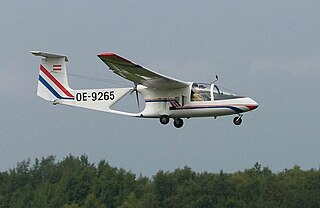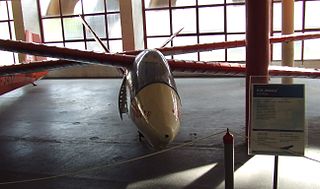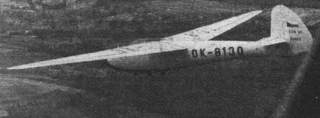Related Research Articles

The SZD-45 Ogar (Hound) is a T-tailed cantilever high-wing monoplane of wooden, aluminium and fibreglass construction designed and manufactured in Poland.

The Brditschka HB-3, HB-21 and HB-23 are a family of motor gliders of unorthodox configuration developed in Austria in the early 1970s.
The Scanlan SG-1A is an American, single seat, pod-and-boom, high-wing, strut-braced glider that was designed by Thomas W. Scanlan in 1970 and sold in the form of plans for amateur construction.

The Raab Krähe is a West German high-wing, single-seat, pusher configuration motor glider that was designed by Fritz Raab for amateur construction around 1958.
The Akaflieg Darmstadt D-34 sailplanes were a series of experimental single seat sailplanes, designed at the University of Darmstadt in the 1950s and early 1960s to explore the structural and aerodynamic advantages of the then emerging plastics and composite materials.
The Akaflieg Darmstadt D-39 was a single-seat motor glider derived from the D-38 sailplane. Built in Germany in the late 1970s, it was not intended for production and only one was constructed.

The Ikarus Meteor is a long-span, all-metal sailplane designed and built in Yugoslavia in the 1950s. It competed in World Gliding Championships (WGC) between 1956 and 1968 and was placed fourth in 1956; it also set new triangular-course world speed records.

The Rubik R-25 Mokány, in English: Plucky person and sometimes known as the R-25 Standard (class), is a Hungarian single seat Standard Class glider of all-metal construction, first flown in 1960. It was one of a series of similar aircraft designed by Ernő Rubik. Only one was built.
The Horikawa H-22B-3 is a simple, open frame, two seat primary trainer glider designed and built in Japan in the 1950s.
The Aérostructure Lutin 80, earlier known as the PLM 80, is a small, single seat motor glider with a low power pusher configuration engine, designed and built in France in the 1980s. Only two were completed.
The Corcoran 65-1 was a motor glider of very unusual configuration, a twin engine biplane. It was designed and built in the United States in the 1960s; only two were completed.
The Scheibe SF-30 Club-Spatz is a 15 m class single seat sailplane built in Germany in the 1970s and intended for club use.
The Kortenbach & Rauh Kora 1 was an unusual twin boom, pusher configuration motor glider, designed and built in Germany in the 1970s and intended as a training aircraft.
The KAI-14 was a Standard Class sailplane designed and built in the USSR in the 1960s. Two participated in the World Gliding Championships of 1965.

The Orlican VT-16 Orlik is a single-seat club glider, serving Czech gliding clubs and setting several national records in the early 1960s.
The IIL IS-5 was a single seat, high performance sailplane designed by Iosif Șilimon and built in Romania in 1960.
The IIL IS-7 was a two-seat, sailplane designed by Iosif Șilimon and built in Romania in the late 1950s. Only one prototype was built.
The IIL IS-8 was a two-seat sailplane designed by Iosif Șilimon and built in Romania in 1960. They served with Romanian gliding clubs.
The IIL IS-11 was an aerobatic, single seat glider, designed and built in Romania in 1959. It was built in small numbers.

The Zlín Šohaj series of club gliders began as a post World War II development of the DFS Olympia Meise. A large number were built in the 1940s and '50s.
References
- 1 2 3 4 5 Hardy, Michael (1982). Gliders & Sailplanes of the World. London: Ian Allan Ltd. pp. 137–8. ISBN 0 7110 1152 4.
- 1 2 Coates, Andrew (1980). Jane's World Sailplanes and Motor Gliders. London: Jane's Publishing Company. p. 112. ISBN 0 7106 0017 8.
- ↑ "Fk history". Archived from the original on 25 April 2012. Retrieved 8 January 2014.
- ↑ Partington, Dave (2010). European registers handbook 2010. Tonbridge, UK: Air Britain (Historians) Ltd. ISBN 978-0-85130-425-0.